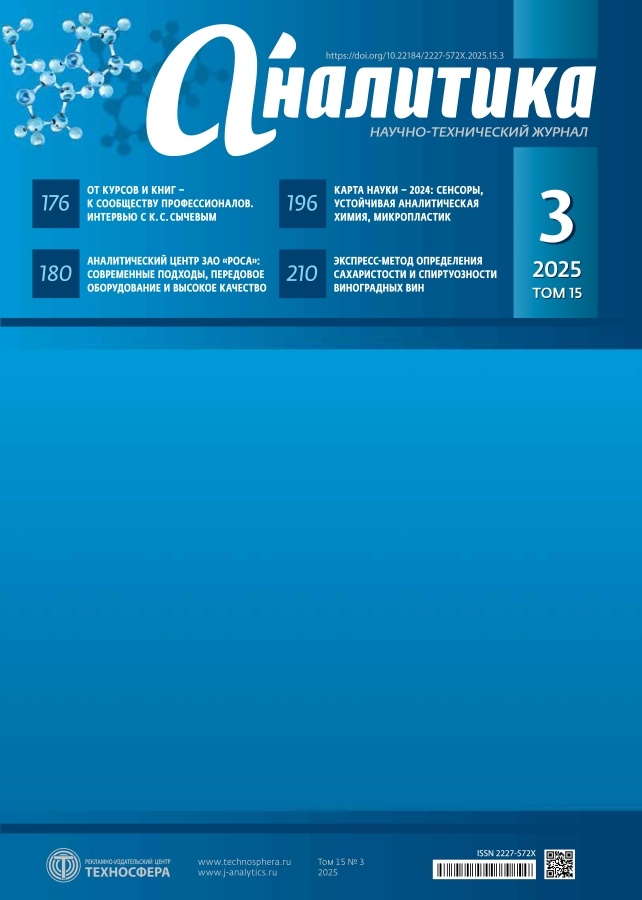Science Map 2024: Sensors, Sustainable Analytical Chemistry, Microplastics
- Authors: Milman B.L.1
-
Affiliations:
- ФГБУ «НКЦТ им. С.Н. Голикова ФМБА России»
- Issue: Vol 15, No 3 (2025)
- Pages: 196-202
- Section: Аналитика веществ и материалов
- URL: https://journals.eco-vector.com/2227-572X/article/view/686825
- DOI: https://doi.org/10.22184/2227-572X.2025.15.3.196.202
- ID: 686825
Cite item
Abstract
This publication is the seventh in a series of articles containing the results of regular scientometric monitoring of analytical chemistry. The identified cutting-edge areas (fronts) of research are based on highly cited publications, grouped into clusters by frequent cocitation. In 2024, as before, there are many areas of research and development related to sensor devices used in medical diagnostics (COVID‑19, etc.), as well as in the analysis of environmental objects and food products. Attention to microplastics, an environmental pollutant, remains high. An extensive scientific field has emerged in which analytical methods are considered according to conditional criteria of colourfulness.
Full Text
About the authors
Boris L. Milman
ФГБУ «НКЦТ им. С.Н. Голикова ФМБА России»
Author for correspondence.
Email: bormilman@yandex.ru
ORCID iD: 0000-0002-0609-6117
Dr.Sc., Research Leader, Clinical Research Center of Toxicology
Russian Federation, Санкт-ПетербургReferences
- Milman B. L., Ostrovidova E. V., Zhurkovich I. K. Chemistry-2018. New “hot” research fields. Analytics. 2019; 9(4):314–319. (In Russ.).
- Milman B. L., Lugovkina N. V., Zhurkovich I. K. Front research in chemistry. 2012–2020. Analytics. 2021; 11(5): 402–408. (In Russ.).
- Milman B. L., Zhurkovich I. K. Map of analytics-2022: miniaturized instruments, COVID-19, microplastics, deep eutectics. Analytics. 2023; 13(5): 360–365. (In Russ.).
- Research Fronts. URL: https://english.casisd.cn/events/202311/t20231130_653115.html.
- Research Fronts. URL: https://discover.clarivate.com/Research_Fronts_2024_EN.
- Milman B. L., Zhurkovich I. K. Topical research fields in analytics. 2019–2023. Analytics and Control. 2024; 28(3): 244–250. (In Russ.).
- Google Scholar Metrics. URL: https://scholar.google.ru/citations?view_op=top_venues&hl=ru&vq=chm_analyticalchemistry.
- Sustainable development. URL: https://ru.wikipedia.org/wiki/Устойчивое_развитие.
- Biomedical Sensors Market Size. URL: https://www.mordorintelligence.com/industry-reports/biomedical-sensors-market.
- Fan M., Andrade G. F.S., Brolo A. G. A review on recent advances in the applications of surface-enhanced Raman scattering in analytical chemistry. Analytica Сhimica Acta. 2020; 1097:1–29.
- Wang B., Wang R., Wang D., Wu J., Li J., Wang J., Liu H., Wang Y. Cas12aVDet: a CRISPR/Cas12a-based platform for rapid and visual nucleic acid detection. Analytical Сhemistry. 2019; 91(19):12156–12161.
- Nowak P. M., Wietecha-Posłuszny R., Pawliszyn J. White analytical chemistry: an approach to reconcile the principles of green analytical chemistry and functionality. Trends in Analytical Chemistry. 2021; 138:116223.
- Richter P., Cárdenas S. Sustainability in sample preparation. Analytical and Bioanalytical Chemistry. 2025; 1–2. URL: https://doi.org/10.1007/s00216-024-05722-x.
- Milman B. L., Zhurkovich I. K. Micro-and Nanoplastics. Contours of the Problem. Analytics. 2024; 14(4): 328–337. (In Russ.).
- Microfluidics Market Size. URL: https://www.towardshealthcare.com/insights/microfluidics-market-sizing.
Supplementary files









